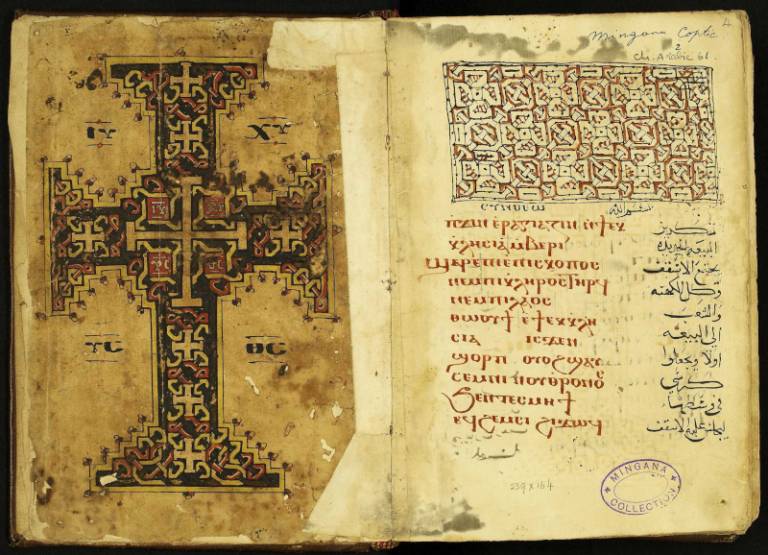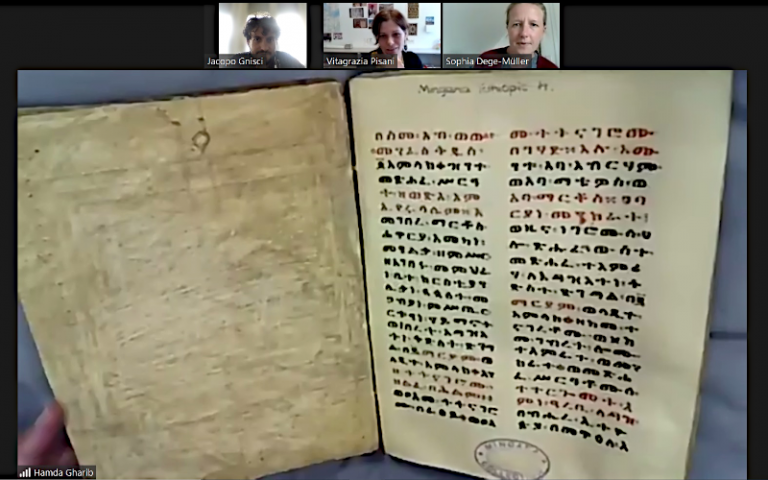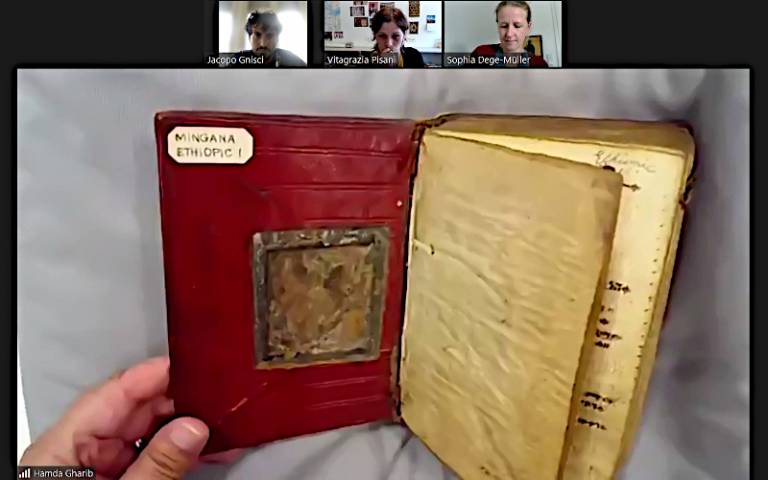By Sophia Dege-Müller and Jacopo Gnisci
The Mingana collection, which is housed by the University of Birmingham's Cadbury Research Library, comprises some 3,000 oriental manuscripts. The core of this corpus was assembled in the 1920s by Alphonse Mingana – an Assyrian Church of the East priest born in Iraq who decided to become an orientalist scholar. The collection includes some beautiful examples of Coptic, Armenian, and Syriac manuscript illumination, as showcased by an early 14th century Copto-Arabic Ritual for the Consecration of a New Church (MS M. Chr. Arab. 61, Fig. 1) that is decorated with motifs, such as the interlace cross at fol. 3v, that bear comparison with the decorations of near coeval Ethiopic illustrated manuscripts.

Fig. 1. Copto-Arabic manuscript with Cross Frontispiece and Ritual for the Consecration of a New Church, 1308 AD, Birmingham, Cadbury Research Library, University of Birmingham, MS Mingana Chr. Arab. 61, fols. 3r–4r (Photo: Cadbury Research Library, University of Birmingham)
Because we were aware of the presence of some Ethiopic materials in the Mingana collection, through our scoping of UK and German collections for ITIESE, we contacted the library to help us determine if it owned any manuscript that could be relevant to the project. Thanks to an online Zoom consultation, which was kindly offered to us by the library’s staff, we were able to quickly and easily inspect their Ethiopic manuscripts in early September 2021 notwithstanding the additional complications generated by the pandemic. The Mingana library owns four Ethiopic manuscripts as well as a scroll. The library’s records contain limited information on how these manuscripts were acquired. We knew that the scroll, which has been described in one of the catalogues of the collection, is relatively recent (Hunt 1997, No 94). However, the four manuscripts were known only through a handlist which proved to be quite inaccurate. The Ethiopic collection consists of two Psalters (MSS M. Eth. 1 and Eth. 2), a scroll (MS M. Eth. 3), a Miracles of Mary (MS M. Eth. 4, Fig. 2), and a Deggwa – that is an Antiphonary (MS M. Eth. 5).

Fig. 2. The team look at a manuscript oft he Miracles of Mary in Ethiopic, c. 19th–20th century, Birmingham, Cadbury Research Library, University of Birmingham, MS Mingana Eth. 4, fols. 1v–2r (Photo: Cadbury Research Library, University of Birmingham)
Unfortunately, the collection did not include any examples of manuscript illumination from the early Solomonic period. Nevertheless, through the zoom consultancy we were able to extend the description of the manuscripts, identify some features that were previously unnoticed, such as two niches in the boards of MS M. Eth. 1 (a Psalter - መዝሙረ ዳዊት), which presumably held small mirrors (Fig. 3), and share this information with the library. We also really enjoyed the experience of consulting manuscripts online and found that the service offered by the library was extremely valuable, in that it saved us the time and resources that would have been necessary to travel to Birmingham to consult them in person.

Fig. 3. The team look at a niche in the board of an Ethiopic Psalter, c. 18th century, Birmingham, Cadbury Research Library, University of Birmingham, MS Mingana Eth. 1 (Photo: Cadbury Research Library, University of Birmingham)
We extend our thanks to the Cadbury library staff for facilitating this wonderful experience!
 Close
Close

